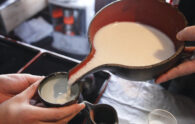This year will prove to be an important one for the International Linear Collider project. All signs indicate that the Japanese national government will make their decision whether or not to host the ILC sometime from the end of 2017 to 2018. It is vital for all related parties to continue to urge the government to host the project, but we also must be prepared – if and when the green light is given to the ILC, all of us must be ready to “accelerate” ILC initiatives. To that end, Shigeki Chiba, Vice-governor of Iwate travelled to Europe in January 2017 to see some of its large scientific research facilities … and to glean insights that will be helpful as Iwate prepares an environment that can receive the ILC.
THE KITAKAMI TIMES sat down with the Vice-governor to hear his thoughts, as well to learn what’s in store for Iwate and the ILC this year.
What were your impressions of CERN, the largest research facility for particle physics in the world?
CERN is surrounded by natural beauty, with nearby pastures and fields, and Mont Blanc, Lac Leman, and the Jura Mountains in the background. I was reminded of how much the area has in common with Iwate Prefecture, like Mount Iwate and the Sanriku Sea.
At CERN, I had fruitful discussions with Lyn Evans, the director of the Linear Collider Collaboration, and Akira Yamamoto, a professor from KEK and former regional director for Asia in the LCC. A great achievement of this trip was the fact that I was able to affirm the mutual cooperative relationship between Iwate Prefecture and the researchers working for the ILC.

Vice-governor Chiba gives LCC Director Lyn Evans a gift from Iwate
What was the most impressive thing you saw at CERN?
They showed us places that are normally closed to visitors – we were able to see them because the beam was down for maintenance. These machines up close really are different from the pictures. I was very impressed with Point 4, one of the LHC access points located in the countryside. There, Lyn Evans and Marzia Bernardini showed us the LHC accelerator deep underground. We also got to see ATLAS, the detector that records the data of the particle collisions. I once again was able to see how large these experiments really are.

Right by the real thing – the Large Hadron Collider. From left to right: Prof. Osamu Sasaki (KEK), Prof. Akira Yamamoto (KEK), Amanda Wayama, LCC Director Lyn Evans, EN-ACE-OSS Section Leader Marzia Bernardini, Vice-governor Chiba, Director Jun Sasaki of Iwate’s ILC Promotion Office, Akihiro Kikuchi, Toshiyuki Sato
We also saw what it’s like to live in the area surrounding CERN. Was there anything you saw that you thought we should prepare in Iwate?
There were certainly things that I felt were necessary if the ILC becomes a reality. When we saw the cafeteria at CERN, there was so much informal communication going on. Of course there is plenty of discussions and exchange between researchers when they’re working, but even during lunch, people are still hard at work! At CERN, there are so many places for communication, both formal and informal. I think that is extremely important for a research facility.

Vice-governor Chiba by the Standard Model Stone outside the CERN Control Centre
We also need to create a research facility in harmony with the surrounding environment. I think they’ve done a great job of that at CERN. The facility (Point 4) melds right in with the forests and mountains. The Iwate Prefectural Government will be able to cooperate in that manner. I also think they’ve paid close attention to the people living in the area, creating bike paths and spots where you can learn more about CERN. Those are things that the government can help create when building the facility.
Linear Collider Workshop 2016 held in Morioka in December was a rousing success. The year 2017 will be a moment of truth for the project, as the Japanese national government is scheduled to make their decision this year. As the candidate site for the ILC, what are Iwate’s plans for the year?
The researchers at LCWS 2016 shared an approach for reducing costs of the ILC, called staging (building the ILC in stages and steadily ramping up its capabilities), and there were further discussions about what can be done to make the project a reality. There was also a message from the Chair of the non-partisan Federation of Diet Members for the ILC, Hon. Takeo Kawamura, who called for “Science First with the ILC.” The LCWS was a leap forward towards the realization of the ILC. It was also a wonderful opportunity for us in Iwate to see what the future with the ILC would be like.
Governor Tasso said in his first press conference of 2017 that this year would be a moment of truth for the ILC. It is very important for the Tohoku region to work as one, with the Tohoku ILC Preparation Office at the center. Iwate Prefecture will make use of the Iwate ILC Coordination Office and carry out its own role within the ILC effort, and we think it’s important to make an even greater effort to spread enthusiasm for the project throughout Japan and the rest of the world, as well as petition the national government.

A cryomodule made through a partnership of the USA and Japan. From left to right: Prof. Akira Yamamoto (KEK), Amanda Wayama, Vice-governor Shigeki Chiba, Director Jun Sasaki of Iwate’s ILC Promotion Office
We will use the relationships formed with researchers through both LCWS 2016 and this visit to help us improve our education, healthcare, and other systems, in order for researchers and their families to have a comfortable life here in the region. The whole prefecture is working towards preparing itself to receive the ILC in this way.
Additionally, last year we started the ILC Caravan*, which will proactively spread awareness of the project throughout Iwate, and work to increase ILC fervor in the Iwate people.
*A traveling lecture series about the basics of the ILC, its economic and societal impact, and ILC initiatives carried out in the region.
What is the message of the ILC Caravan?
We want to increase interest in the ILC, particle physics, and fundamental science in our young people. We want them to know what kind of research will take place at the ILC, and what kind of role it will have in the region. We also want the people of Iwate to see that the ILC’s research will have many effects on healthcare and other fields. So I think it’s important to use the ILC Caravan to inform the Iwate people of the big picture of the ILC.

Vice-governor Chiba during the interview (in Geneva)
What will the Iwate Prefectural government be doing to encourage a speedy decision from the Japanese national government?
We have to stress that the ILC facility will have a very wide, varied role to play through its contributions to related fields. It is important for us to strengthen our partnership with business and academia, and work together with all related parties to petition the national government so that they will decide on the ILC’s position in their policies this year.
Do you have any messages for the researchers abroad?
Iwate is blessed with abundant nature and a culture that has lived in harmony with that nature for centuries. It is the perfect place to do research. Should the ILC become a reality, we will do everything in our strength to support its creation so that you may all come to Iwate to do your research.
I also want to thank everyone from the LCWS for coming to Iwate. And for all of you out there who have not yet had the chance to visit, we have so much to enjoy, from our beautiful nature, delicious food, to our rich cultural heritage.
Is there any particular Iwate cultural heritage you’d like our readers to know about?
One uniquely Iwate thing would be our folk arts. These are dances and performances that were performed by normal people in their respective towns and villages, and they all developed distinctly from one another. One of those would be the Hayachine Kagura dance, which has been designated an intangible Cultural Heritage of Humanity by UNESCO. Another thing I think people would be interested in is our Sanriku Geopark. This park stretches down the entire coast of Iwate, with a number of unique geological formations as well as reminders of the lessons learned from the 3.11 tsunami. We are currently a Japanese national geopark, but are aiming for a bid towards global geopark status from UNESCO.
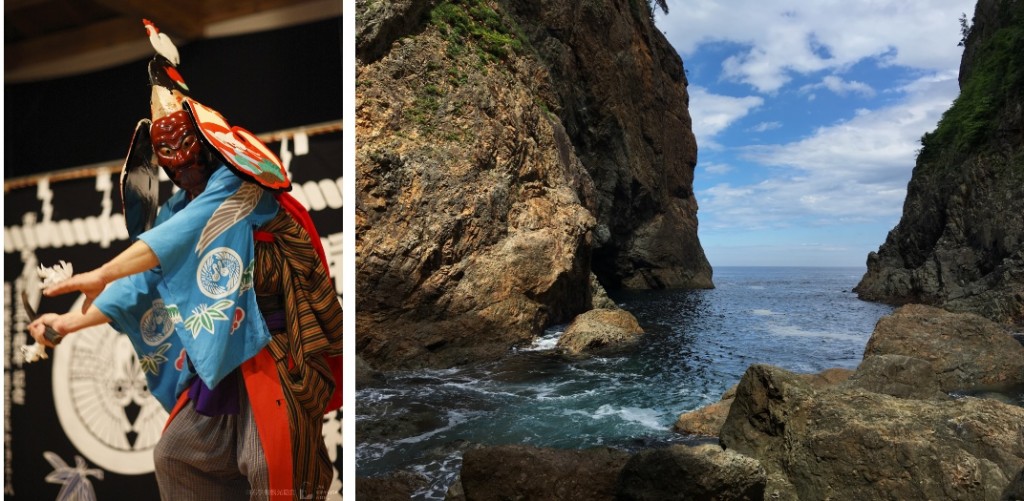
Hayachine Kagura (left), Sanriku Geopark – Tanohata coast (right)
Finally, to all those reading THE KITAKAMI TIMES: I am deeply counting on your cooperation in spreading the news about Iwate, Tohoku, and the ILC project!
The Iwate ILC Office team continues on to CEA Saclay and DESY!
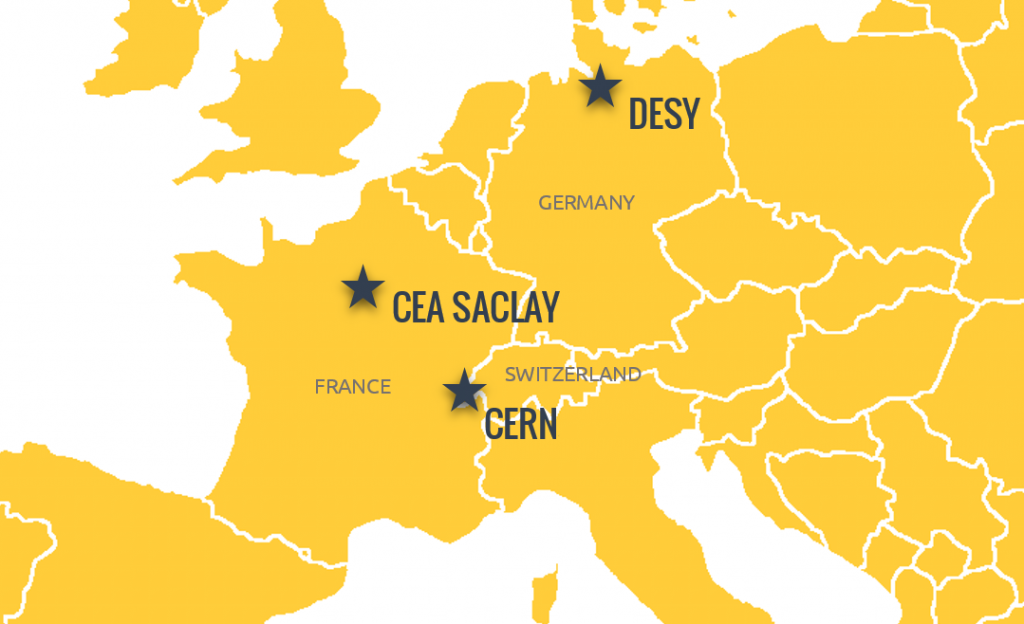
*New to the ILC? We’ve got a glossary at the end of the article for all these acronyms.
While the Vice-governor spent some more time in France to promote Iwate tourism and specialty goods, the accompanying staff from the Office of Science and ILC Promotion (and yours truly) had a double-hitter tour of CEA Saclay outside of Paris, France, and DESY in Hamburg, Germany. At Saclay, we toured a former cryomodule production facility and spoke with officials from Irfu and IN2P3, two French institutions that focus on subatomic and astroparticle physics. These two institutions are actually funded by two different agencies (CEA & CNRS) with separate missions, but on the topic of the ILC, the two fulfill important roles in Europe and cooperate together.
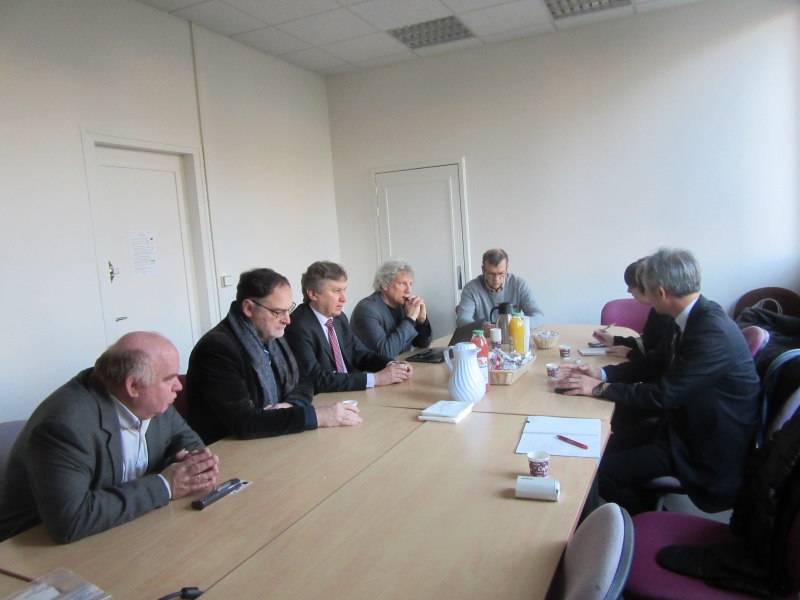
Meeting with officials at CEA Saclay. From left to right: Paul Colas, Nicolas Alamanos, Maxim Titov, Marc Winter, Olivier Napoly, Amanda Wayama, Jun Sasaki
Then we flew to Hamburg, Germany to visit DESY, which is home to many different types of accelerator-based research. It was here that the superconducting radiofrequency technology used to accelerate particles in the ILC was developed. Not only did we get to see PETRA III, their synchrotron facility, but also the HERA collider, and the test facility for the cryomodules produced at CEA Saclay. Yes, these cryomodules are an international project – a hundred in all built to construct the European XFEL.

Joachim Mnich, director for particle physics and astroparticle physics at DESY, shows off a model of the European XFEL
The European XFEL – the European X-ray Free Electron Laser – kept coming up during these visits. This research facility is currently being built at DESY, and will be home to a linear particle collider that uses the SCRF technology to bring electrons to a high energy state – very similar to the ILC! In fact, in some ways the XFEL could be seen as a mini-ILC, and a test run for implementing technologies that will be needed for the ILC. It’s also another example of what countries can do when they work together on fundamental science research.
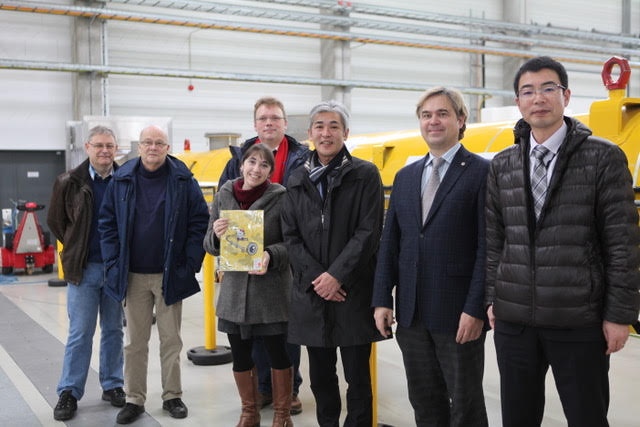
In front of an XFEL cryomodule at DESY. From left to right: Nick Walker, Klaus Sinram, Karsten Buesser, Amanda Wayama, Jun Sasaki, Ivor Fleck, Toshiyuki Sato, and behind the camera, Barbara Warmbein (Photo credit: DESY)
During our talks, it was reiterated that the ILC will require more than just general cooperation with “Europe.” This trip was useful for getting a sense of the different governmental structures involved with each country. Plus, our appreciation goes out to the warmth and generosity of all of the people who hosted us. As we gear up for this important year for the ILC, we know we have our friends overseas to guide us and help make the ILC dream come true.
Glossary
CERN
The European Organization for Nuclear Research, located in Geneva near the border of France and Switzerland. Otherwise known as the largest particle physics laboratory in the world, with 22 member states. CERN is home to the Large Hadron Collider, where the discovery of the Higgs particle was made in 2012. The ILC will further study the properties of this particle.
KEK
Japan’s High Energy Accelerator Research Organization (Kou enerugii kasokuki kenkyuu kikou). The leading body in Japan for particle physics research and for pushing forth the ILC project.
CEA
The French Alternative Energies and Atomic Energy Commission (CEA) is a key player in the domains of defense and security, nuclear energy (fission and fusion), technological research for industry, and fundamental research in the physical and life sciences. The CEA Saclay Research Center is located outside of Paris and is also the place of the CEA Headquarters.
IRFU
IRFU, Institute of Research into the Fundamental Laws of the Universe, is a basic institute of the CEA’s Direction for Fundamental Research, which covers the fields of astrophysics, nuclear physics, and particle physics.
CNRS
The National Center for Scientific Research (CNRS) is a public organization which carries out academic research in all fields of knowledge through its ten institutes.
IN2P3
The Institute of Nuclear and Particle Physics (IN2P3) is one of the CNRS institutes, which acts as coordinator in the fields of nuclear, particle and astroparticle physics, and contributes to the technological advances in the health and energy sectors, from the academic point of view.
DESY
The Deutsches Elektronen-Synchrotron, a national particle physics laboratory in Hamburg, Germany.
LHC
Large Hadron Collider. This circular particle collider is the largest in the world at 27km. The Higgs particle was discovered by this machine in 2012.
ATLAS
One of the massive detector devices (like a big digital camera) that record the collisions at LHC.
European XFEL
The European x-ray free electron laser (European XFEL) is currently under construction in Hamburg, Germany. Within this facility is a 2.1 km long superconducting linear accelerator – kind of like a mini-ILC.
PETRA III
The most brilliant storage ring based X-ray source worldwide.
HERA
No longer operating, but was DESY’s largest particle accelerator.
SCRF
Superconducting radiofrequency. A technology used to accelerate particles to high energies, developed at DESY. This will be used at the ILC.
Cryomodule
Within these devices are SCRF cavities that are super-cooled to allow particles to accelerate to blinding speeds. Lining up 100 in a row will get you the European XFEL, while it will take around 2,000 to create the ILC.
(Special thanks to Maxim Titov of Irfu (CEA), Marc Winter of IN2P3 (CNRS), and Barbara Warmbein of DESY for their help with this article)
Japanese
岩手県がCERN、サクレー研究所、DESYを訪問ILCの実現に向けて、千葉副知事が今回の視察で得た情報を活かします
和山アマンダ
2017年は、国際リニアコライダー(ILC)の実現に向けて重要な一年です。2017年末から2018年に、日本政府のILC誘致決定が判断されると考えられており、関係者による政府への要望や、青信号が出された場合、ILCの受入環境の整備を加速できるように準備を進めることが極めて重要です。そのため、千葉茂樹岩手県副知事は、2017年1月にヨーロッパにある欧州原子核研究機構(CERN)を訪問し、今後、岩手が受入環境の整備を進めるために必要な情報収集を行いました。
THE KITAKAMI TIMESでは、今回の視察の感想や、この一年におけるILCの実現に向けた取組を伺うため、副知事にインタビューを行いました。
Q)まず、世界最大規模の素粒子物理学研究施設であるCERNを訪問した率直な感想をお聞かせください。
A)CERNの周辺には牧場や畑が多く、モンブランやレマン湖、ジュラ山脈などの自然環境が豊かで、岩手山や三陸の海などを有する本県との類似点が多いと改めて感じました。
LCCの代表であるリン・エバンス氏、KEKの山本明先生(LCCの元アジア地域・ディレクター)と様々な点で、充実した意見交換を行い、研究者側と本県の相互の協力体制を確認できたとことが大きな成果と捉えています。
Q)CERNで最も印象的に感じたことは何ですか。
A)施設がメンテナンス中だったため、普段は立ち入りできない施設を見ることができました。写真で感じる規模感とは全く違うと思いました。リン・エバンス氏に説明いただいたLHCのアクセスポイント(ポイント4)や、マルツィア・ベルナルディニ氏に説明いただいたATLASの内部に入ることができ、実験設備の大きさを改めて実感しました。
Q)セルン周辺の住環境について、岩手にも作りたい施設はありましたか。
A)はい。例えば研究者の交流、インフォーマルなコミュニケーションが非常に活発にされるような施設が必要だろうと感じました。また、昼食時になると、非常にたくさんの職員がここで仕事をしていることが改めて分かり、施設の規模がものすごく大きいと感じました。CERNでは勤務時間中のコミュニケーションと、それ以外のインフォーマルコミュニケーションが、しっかり区別されていると強く感じました。こういう施設が研究機関には非常に重要だと思いました。
また、自然環境と調和した施設が必要です。CERNでは、施設の建物が周辺の森林に溶け込んでおり、自然環境との調和に十分配慮していると感じました。この点は行政としても協力できる部分ではないかと思います。また、自転車道路や、研究内容を学べる屋外展示施設が整備されているなど、付近の住民に対する様々な配慮を感じました。この部分についても、行政側がサポートできると思います。
Q)昨年12月に盛岡市で開催されたLCWS2016は大成功でした。2017年は、日本政府の誘致表明に向けて、正念場の1年になると思いますが、建設候補地として、ILC実現に向けて、どのように取り組んでいく予定でしょうか。
A)LCWS2016では、建設コスト削減に効果があるステージング(段階付け)の方向性を研究者同士が共有し、ILC実現に向けた議論の進展が図られました。また、超党派の国会議員による議員連盟の会長、河村建夫衆議院議員による「サイエンス・ファーストwith ILC」のメッセージは、ILC実現に向けて大きな一歩となりました。さらに、岩手にILCができればこうなるという未来を先導するような一週間で、本県にとって、極めて貴重な機会となりました。
ILC実現に向けて、今年はまさに、知事が年頭の記者会見で述べたように、正念場の一年、大切な1年と思っています。昨年6月に設置された「東北ILC準備室」を中心に、東北が一丸となって取り組んでいくことが極めて重要と捉えており、岩手ILC連携室も活用しながら、本県の役割をしっかりと発揮し、国内外の機運醸成や国等への要望活動をこれまで以上に強力に進めていく必要があると思います。
具体的には、LCWS2016と今回の訪問等で構築した研究者とのネットワークを活用し、子どもの教育環境や医療体制の充実など、研究者の皆さんとその家族が、安心して快適に暮らすことができる受入環境の整備に向けて全県を挙げて取り組んでいきます。
また、昨年から活動を開始した「ILCキャラバン」*など県内での普及啓発を積極的に展開し、県民のさらなる機運醸成に努めていきます
*ILCキャラバンは、岩手県内の各地で開催しているILCのセミナーシリーズです。ILCの基礎知識について学んだり、地域への影響、効果、地域での取組を話し合ったりします。
Q)ILCキャラバンなどの普及啓発では、県民に対してどのようなメッセージを送りたいと思っていますか。
A)岩手の若い世代には、ILCをはじめ、様々な科学に対する関心を持ってもらいたいです。ILCキャラバンでは、ILCではどのような研究が行われるのか、地域の役割などについて紹介します。また、医療をはじめ、ILCから派生する様々な分野や効果についても発信していきます。このように、ILCの全体像を県民の皆さんにお知らせしていく必要があると思っています。
Q)引き続き岩手県として、政府に対する要望を行いますか。
A)一つのポイントは、ILCが幅広い分野に影響を与える施設であることです。今年は、経済界、学界との連携を強化して、関係者が一丸となった要望活動を行い、国に対して早期に誘致決定の判断をお願いしていくというのが、重要だと思います。
Q)海外で活躍する研究者に向けて一言お願いします。
A)岩手には、自然と共生した文化が息づいており、研究環境には最適の地です。ILCが実現した際には、是非、岩手で研究を行っていただけるよう、全力でILCの実現をサポートしてまいります。
LCWSに参加された皆さん、岩手にお越しいただき、ありがとうございました。そして、まだ岩手を訪れたことがない皆さん、岩手には、豊かな自然、おいしい食、魅力的な文化などがたくさんあります。是非、岩手へお越しください。
Q)岩手特有の文化の中で研究者に紹介したいものはありますか。
A)一つは郷土芸能です。県内各地で独自の郷土芸能が発展していますので、早池峰神楽(ユネスコの無形文化遺産)などの郷土芸能をPRしたいと思います。
次に、三陸ジオパークです。岩手県の海岸は特徴的な地理・地質であり、地球の活動によって形成された様々な自然の造形を見ることができます。さらに三陸ジオパークでは、東日本大震災津波から得た教訓も学ぶことができます。現在、日本ジオパークの認定を受けていますが、今後は、ユネスコ世界ジオパークの認定を視野に入れ、様々な取組を行っていきます。
最後に、THE KITAKAMI TIMESをご覧の皆さんには、ILCについて関心を持っていただき、積極的に情報を発信いただくよう心からお願いいたします。
-----------------------------
岩手県のILC推進担当がサクレー研究所とDESYを訪問しました!
*専門用語集をご用意しましたので、記事の下をご覧ください。
その後、千葉副知事は、フランスでの観光物産振興の用務に向かい、私を含む岩手県のILC推進担当はパリ郊外のサクレー研究所、そして、ドイツのハンブルグにあるDESYを訪問しました。サクレー研究所では、以前、クライオモジュールが製作されていた施設を視察し、その後、素粒子・天体粒子物理学を研究するフランスの研究機関、IrfuとIN2P3の代表と意見交換を行いました。IrfuはCEAから、IN2P3は、CNRSからの資金を受けて研究に取り組んでいます。それぞれの目的は異なりますが、ILCに関しては、欧州においてそれぞれ重要な役割を持ち、両者が協力しています。
その後、ドイツのハンブルグに向かって、様々な研究が行われるDESY(ドイツ電子シンクロトロン)を訪問しました。実は、DESYでは、ILCで使われる、粒子を加速させる技術である「超伝導高周波(SCRF)空洞技術」が開発されました。放射光施設「PETRAⅢ」だけでなく、円形加速器「HERA」と、サクレー研究所で製作されたクライオモジュールの性能試験施設を紹介いただきました。ヨーロッパX線自由電子レーザー(XFEL)の建設にあたり、100台のクライオモジュールを必要とし、このクライオモジュールは、国際プロジェクトとして製作されたものです。
訪問先では、何度もヨーロッパXFELの話を耳にしました。現在、ヨーロッパXFELの研究施設がDESY周辺で建設されており、その研究施設には、SCRF技術で電子を高エネルギー状態にさせる直線型加速器が作られています。つまり、ILCに似ている装置です。ある意味、XFELは、小型版ILCと考えられ、ILCの建設に必要な技術を先行して実践していると言うことができます。また、複数の国が協力して基礎科学研究に取り組む価値を示す例にもなります。
ディスカッションの中で、ILCを実現させるためには、「ヨーロッパとの協力」というより、ヨーロッパのそれぞれの国と協力関係を作る必要があると改めて感じました。また、今回の訪欧では、各国の政府の仕組みを知るなど、大きな成果となりました。最後に、訪欧にあたり、私たちを温かく迎えてくださった皆さんに心から感謝します。今年は、ILCにとって正念場の一年です。今後は、建設候補地である東北、岩手がILCの実現に向けた受入体制の整備を進める中で、海外の心強い仲間達からいろいろな指導や助言、協力や支援をいただけるものと確信しています。
専門用語集
CERN(セルン)
フランスとスイスの国境をまたがる欧州原子核研究機構(CERN)。メンバーが22か国で、世界最大の素粒子物理研究施設です。CERNでは2012年にヒッグス粒子を発見した大型ハドロン衝突型加速器が設置されています。ILCでは、ヒッグス粒子の特徴を細かく研究します。
KEK
日本の高エネルギー加速器研究機構(KEK)。日本で行われる素粒子物理学研究を中心的な位置からリードし、ILCプロジェクトを進めています。
CEA
フランスの原子力・代替エネルギー庁(CEA)は、国の防衛と安保、核エネルギー(核分裂と核融合)、産業のための技術開発、物理学・生命科学の基礎研究などの面でのキープレイヤーです。サクレー研究所はパリ周辺にあるCEA本部です。
IRFU
宇宙の原理・法則研究施設(IRFU)は、CEAの基礎研究方向の基に管理されている基礎研究施設です。IRFUは天体物理学、核物理学、素粒子物理学を担当しています。
CNRS
フランス国立科学研究センター(CNRS)は、研究所10か所を通して科学のすべての分野において学術研究を行う公的機関です。
IN2P3
国立核物理素粒子物理研究所(IN2P3)は、CNRSの研究所の一つであり、核物理学・素粒子物理学・天体物理学の分野において調整役・まとめ役に努めています。学術的立場から、医療やエネルギー分野において技術開発に貢献しています。
DESY
ドイツ電子シンクロトロン(DESY)は、ドイツのハンブルグに位置しており、国立素粒子物理学研究施設です。
LHC
大型ハドロン衝突型加速器(LHC)は周長27キロメートルである世界最大の加速器です。2012年にヒッグス粒子がここで発見されました。
ATLAS
LHCで粒子の衝突データを記録する測定器(大きなデジタルカメラのようなもの)です。
ヨーロッパXFEL
ヨーロッパX線自由電子レーザー(ヨーロッパXFEL)は現在、ドイツのハンブルグで建設されています。この施設では長さ2.1キロメートルのILCのような直線型加速器が設置されます。
PETRA Ⅲ
世界最大のX線源を蓄積するリング。
HERA
もう稼働していないが、DESY最大の加速器。
SCRF
超伝導のラジオ周波数(SCRF)は、DESYで開発された、粒子を高エネルギー状態に加速させる技術です。この技術はILCにも利用されます。
クライオモジュール
クライオモジュールの中に、SCRF空洞が設置され、粒子を光速の近くまで加速させるためにこの空洞が過冷却されます。100台を並ぶと、ヨーロッパXFELになり、そしてILCが約2000台を必要とします。
(特別な感謝:IRFU(CEA)のマキシム・チトブ氏、IN2P3(CNRS)のマーク・ウィンター氏、DESYのバーバラ・ワームベイン氏)

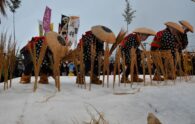
-195x124.jpg)
